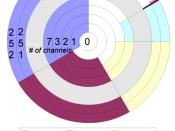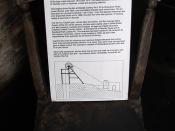Distribution Channels at Clothing Retailer Hennes & Mauritz
A key ingredient in retailing success is the strength of a company's distribution channels. Kerry Capell's (2002) Business Week article looks at Sweden-based Hennes & Mauritz's (H&M) sourcing and inventory management strategies and their reliance on distribution channel partners. H&M has developed a unique distribution channel strategy to compete with better entrenched retailers including Gap, Old Navy, Zara and FCUK.
H&M Product Strategy
Understanding H&M's distribution strategy requires a clear understanding of their product philosophy and strategy. Like Gap and other clothing retailers, H&M markets to a particular segment of the fashion consumer market. H&M's philosophy is "Fashion and quality at the best price" (H&M, 2004). H&M keeps up with its competitors by providing a variety of styles from "updated classics and fashion basics" to cutting-edge fashion trends (H&M, 2004).
Kotler defines the product as a combination of goods and services (Kotler et al, 2001).
H&M seeks a product edge by providing affordable fashion lines similar to its competitors, but with a "fast turnaround" from design to production to sales floor (Capell, 2002). Capell focused on this integrated distribution channel in his article.
Distribution Channel Outline
Marketers often refer to the fourth P, place, as placement, logistics or distribution. Marketers must create a place or a way for logistics and physical delivery to get a product to market and into the hands of target consumers (McColl-Kennedy and Kiel, 2003). A distribution channel refers to the type of intermediary or linkage between producers and consumers. A one-channel distribution network involves only the retailer between producer and consumer. Direct distribution occurs when the producer directly supplies the product to the buyer. The choice of distribution channel depends on a variety of factors, including the type of product. While not all clothing retailers use direct distribution models, H&M and its competitors in the low- and mid-range clothing market use this model to maintain low costs and a fast time to market (Capell, 2002).
Unlike many industries, time-to-market is critical to retail clothiers, as trends and fashions can change quickly. To minimize time-to-market, H&M employs a team of in-house designers in 21 production offices worldwide that work to forecast trends and find inspiration for clothing designs "in everything from street trends, to films, to flea markets" (H&M, 2004). From its headquarters in Stockholm, the company directs a rapid-response manufacturing process to capitalize on design trends immediately (H&M, 2004). H&M moves designs through production and into its retail sales channel with a three week to six month lead time. With low-wage, high-volume production in China and Turkey, the company can maintain low input costs and often outfit its stores with the latest trends within a month of the initial design (Capell, 2002). H&M constantly redefines its distribution strategies in response to changing retail market conditions and production conditions in its worldwide manufacturing centers (Capell, 2002). This adaptation ensures that the company can to improve the efficiency of its production flow.
This model has direct application in H&M's retail stores where it sells its products to consumers. H&M's corporate buyers in Sweden actively manage its inventory, researching itemized sales reports by country, store, and, most importantly, type of merchandise daily (Capell, 2002). The buyers use this information to reallocate production or shipments, reducing potential overstock problems. The itemized reports also allow buyers to maintain a high level of turnover, keeping apparel on the sales floor up to date.
Enhancing the company's competitive advantage in this area, the integrated direct distribution channel ensures that H&M stores receive new shipments daily, giving the company further control over responses to supply and demand shifts (Capell, 2002). The company estimates that each store receives between 500 and 1,000 new items daily, with total sales of over 550 million items annually company-wide. For example, if a particular fashion proves exceptionally popular to men in the U.S., but not in Europe, the company can shift inventory in that product from European stores to meet demand in the U.S. The channel also enables H&M to respond to market segment changes. When its $39 pants line proved too upscale for inner city malls, H&M used its integrated channel to shift that inventory to suburban locations and rotate new inventory into the mall stores (Hjelt, 2004).
As with virtually every industry, H&M's continued success and prosperity depends on efficient distribution channels. H&M has effectively incorporated its supply chain and retail distribution channels into its business strategy. As the company expands more heavily into the U.S. market, its unique streamlined distribution channel will be a critical component of its success.
Works Cited
Capell, Kerry. (2002, November 11). Hip H&M: The Swedish retailer is reinventing the business of affordable fashion. Business Week. 106-109.
Hjelt, Paola. (2004). Will $39 Pants = Profits? H&M was too trendy for many mall shoppers. Fortune.com. Retrieved August 23, 2004 from the World Wide Web at: http://www.fortune.com/fortune/subs/article/0,15114,395434,00.html
H&M. (2004). About H&M. HM.com. Retrieved August 23, 2004 from the World Wide Web at: http://www.hm.com/us/hm/facts_history/srt.jsp
Kotler, P., Armstrong, G., Brown, L. and Adam, S. (1998). Marketing. Sydney: Prentice Hall.
McColl-Kennedy, J.R. and Kiel, G. (2003). Services Marketing. Hoboken, NJ: Wiley and Sons.




